Basic Information
-
Protein expression analysis

-

Strain specific LILRB1 expression analysis in transgenic B-Tg(hLILRB1/hLILRB4) mice by flow cytometry. T cells and B cells of blood were collected from wild-type (+/+) and transgenic B-Tg(hLILRB1/hLILRB4) mice (Tg), and analyzed by flow cytometry with species-specific anti-human LILRB4 antibody. Human LILRB1 was both detectable in T cells and B cells from B-Tg(hLILRB1/hLILRB4) mice but not wild-type mice.
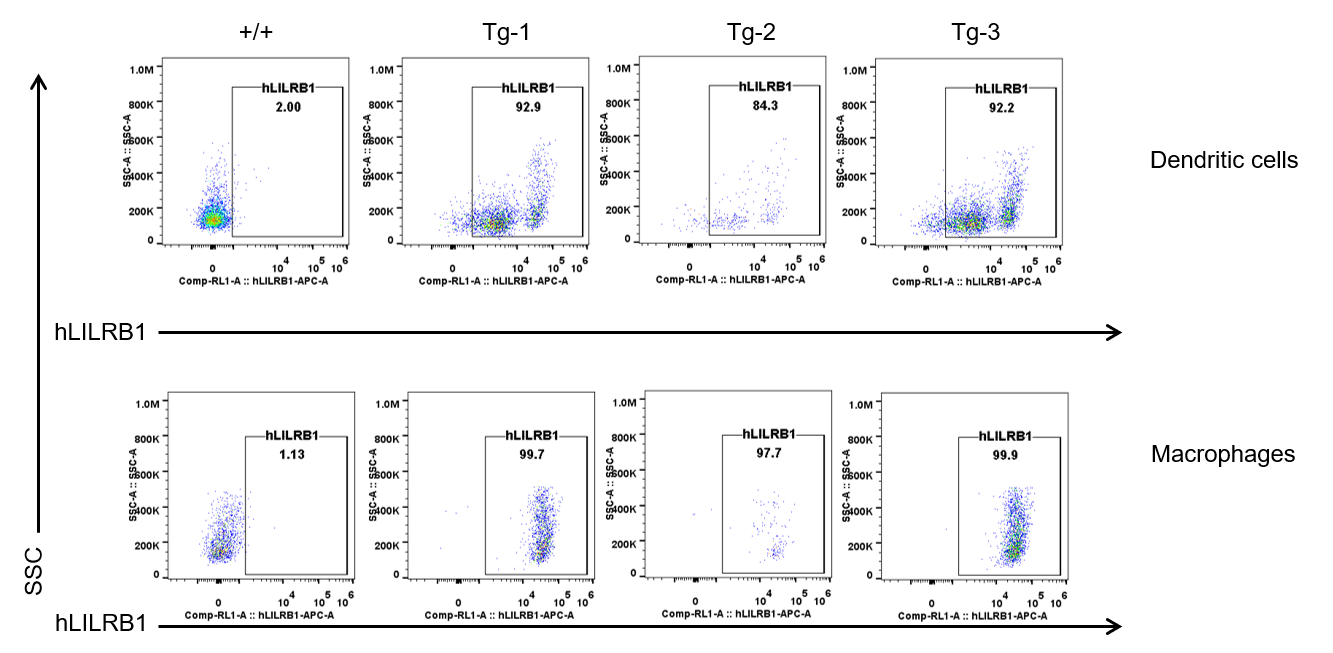
Strain specific LILRB1 expression analysis in transgenic B-Tg(hLILRB1/hLILRB4) mice by flow cytometry. Dendritic cells and macrophages of blood were collected from wild-type (+/+) and transgenic B-Tg(hLILRB1/hLILRB4) mice (Tg), and analyzed by flow cytometry with species-specific anti-human LILRB1 antibody. Human LILRB1 was both detectable in dendritic cells and macrophages from B-Tg(hLILRB1/hLILRB4) mice but not wild-type mice.
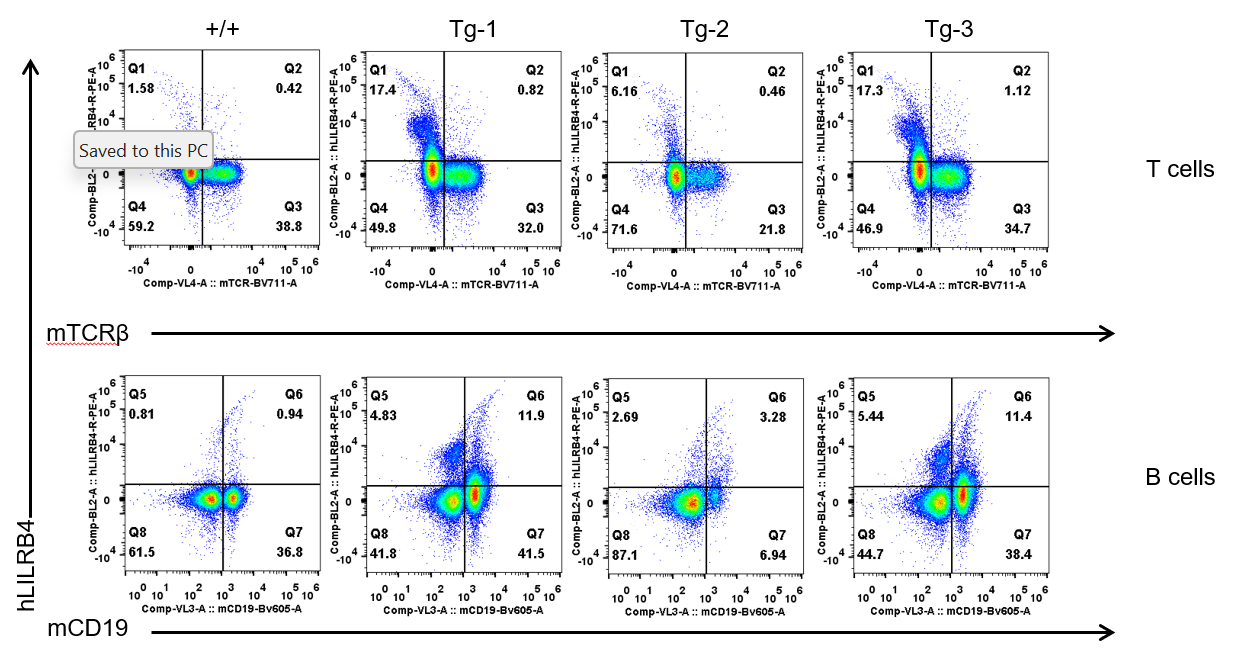
Strain specific LILRB4 expression analysis in transgenic B-Tg(hLILRB1/hLILRB4) mice by flow cytometry. T cells and B cells of blood were collected from wild-type (+/+) and transgenic B-Tg(hLILRB1/hLILRB4) mice (Tg), and analyzed by flow cytometry with species-specific anti-human LILRB4 antibody. Human LILRB4 was not detectable in T cells of B-Tg(hLILRB1/hLILRB4) mice but detectable in B cells.
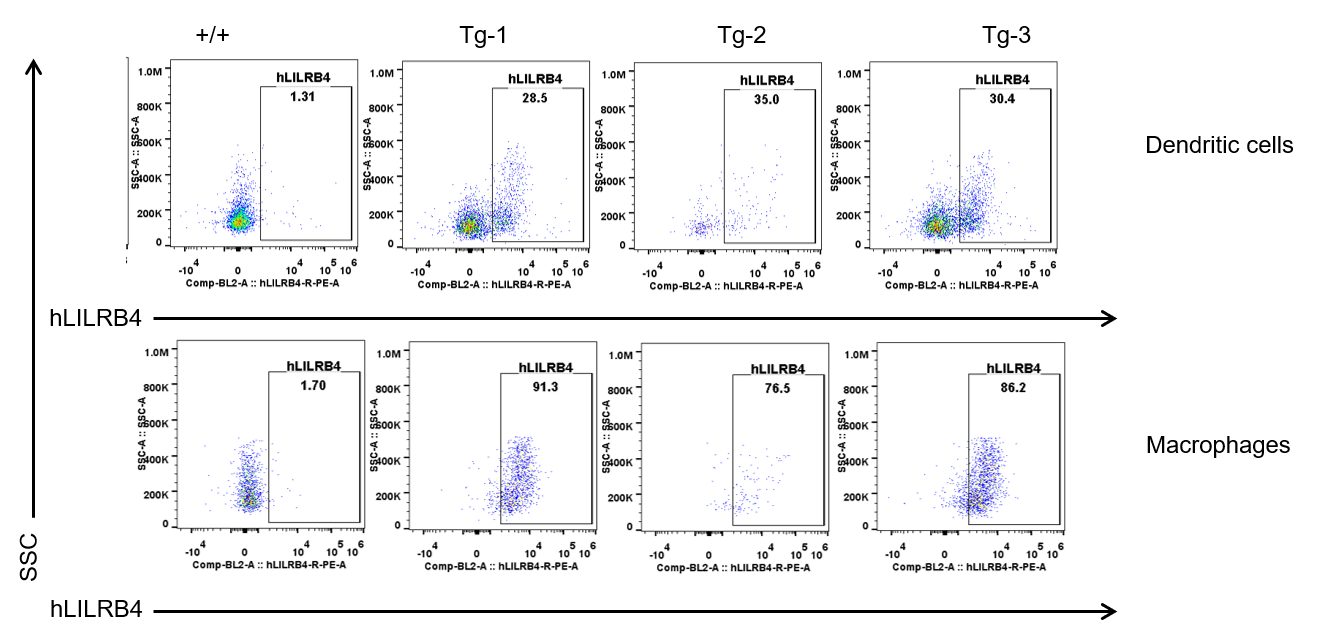
Strain specific LILRB4 expression analysis in transgenic B-Tg(hLILRB1/hLILRB4) mice by flow cytometry. Dendritic cells and macrophages of blood were collected from wild-type (+/+) and transgenic B-Tg(hLILRB1/hLILRB4) mice (Tg), and analyzed by flow cytometry with species-specific anti-human LILRB4 antibody. Human LILRB4 was both detectable in dendritic cells and macrophages from B-Tg(hLILRB1/hLILRB4) mice but not wild-type mice.
-
Immune Cell Profiles

-
Immune Cell Profiles in Spleen

Analysis of spleen leukocyte subpopulations by FACS. Splenocytes were isolated from female C57BL/6 and B-Tg(hLILRB1/hLILRB4) mice (n=3, 8-week-old). Flow cytometry analysis of the splenocytes was performed to assess leukocyte subpopulations. A. Representative FACS plots. Single live cells were gated for the CD45+ population and used for further analysis as indicated here. B. Results of FACS analysis. Percent of T cells, B cells, NK cells, dendritic cells, granulocytes, monocytes and macrophages in B-Tg(hLILRB1/hLILRB4) mice were similar to those in the C57BL/6 mice, demonstrating that LILRB1 and LILRB4 humanized does not change the overall development, differentiation or distribution of these cell types in spleen. Values are expressed as mean ± SEM.

Analysis of spleen T cell subpopulations by FACS. Splenocytes were isolated from female C57BL/6 and B-Tg(hLILRB1/hLILRB4) mice (n=3, 8-week-old). Flow cytometry analysis of the splenocytes was performed to assess leukocyte subpopulations. A. Representative FACS plots. Single live CD45+ cells were gated for TCRβ+ T cell population and used for further analysis as indicated here. B. Results of FACS analysis. The percent of CD4+ T cells, CD8+ T cells and Tregs in B-Tg(hLILRB1/hLILRB4) mice were similar to those in the C57BL/6 mice, demonstrating that introduction of hLILRB1 and hLILRB4 does not change the overall development, differentiation or distribution of these T cell subtypes in spleen. Values are expressed as mean ± SEM.
Immune Cell Profiles in Thymus

Analysis of thymus leukocyte subpopulations by FACS. Thymocytes were isolated from female C57BL/6 and B-Tg(hLILRB1/hLILRB4) mice (n=3, 8-week-old). Flow cytometry analysis of the thymocytes was performed to assess leukocyte subpopulations. A. Representative FACS plots. Single live cells were gated for the CD45+ population and used for further analysis as indicated here. B. Results of FACS analysis. Percent of T cells, B cells, NK cells, dendritic cells, granulocytes, monocytes and macrophages in B-Tg(hLILRB1/hLILRB4) mice were similar to those in the C57BL/6 mice, demonstrating that LILRB1 and LILRB4 humanized does not change the overall development, differentiation or distribution of these cell types in thymus. Values are expressed as mean ± SEM.
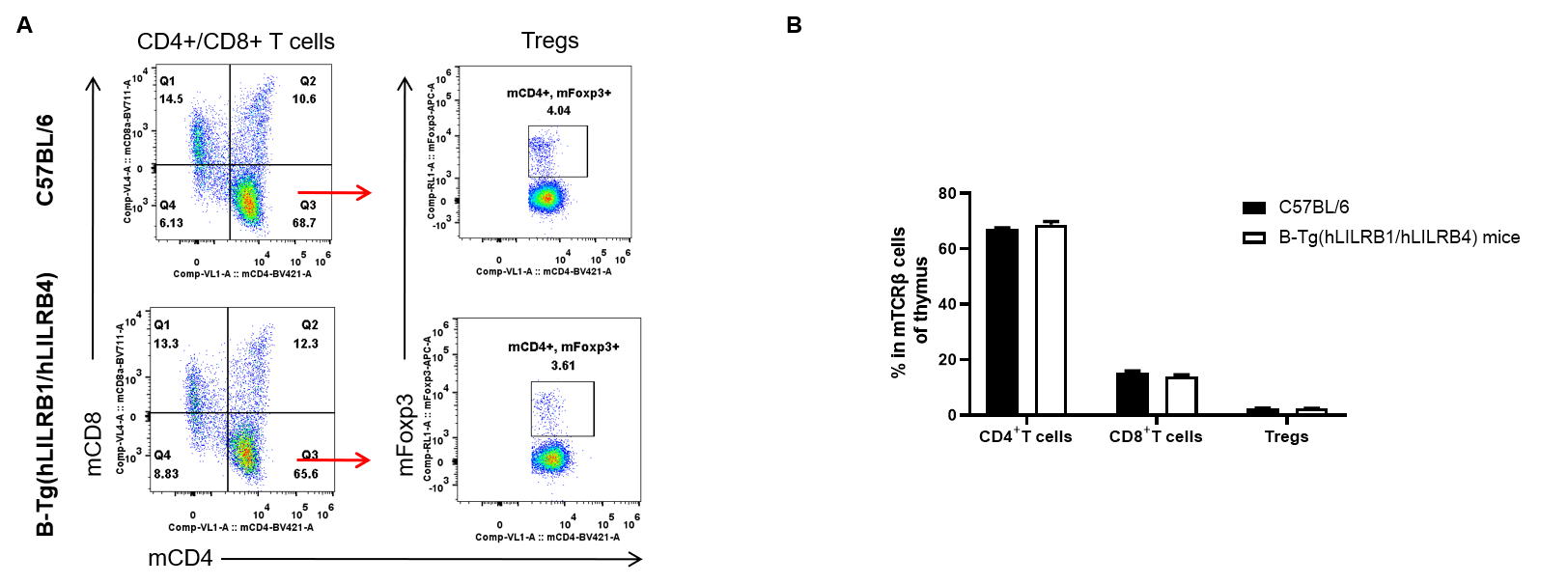
Analysis of thymus T cell subpopulations by FACS. Thymocytes were isolated from female C57BL/6 and B-Tg(hLILRB1/hLILRB4) mice (n=3, 8-week-old). Flow cytometry analysis of the thymocytes was performed to assess leukocyte subpopulations. A. Representative FACS plots. Single live CD45+ cells were gated for TCRβ+ T cell population and used for further analysis as indicated here. B. Results of FACS analysis. The percent of CD4+ T cells, CD8+ T cells and Tregs in B-Tg(hLILRB1/hLILRB4) mice were similar to those in the C57BL/6 mice, demonstrating that introduction of hLILRB1 and hLILRB4 does not change the overall development, differentiation or distribution of these T cell subtypes in thymus. Values are expressed as mean ± SEM.
Immune Cell Profiles in Bone Marrow

Analysis of bone marrow leukocyte subpopulations by FACS. Bone marrow leukocyte were isolated from female C57BL/6 and B-Tg(hLILRB1/hLILRB4) mice (n=3, 8-week-old). Flow cytometry analysis of the bone marrow leukocyte was performed to assess leukocyte subpopulations. A. Representative FACS plots. Single live cells were gated for the CD45+ population and used for further analysis as indicated here. B. Results of FACS analysis. Percent of T cells, B cells, NK cells, dendritic cells, granulocytes, monocytes and macrophages in B-Tg(hLILRB1/hLILRB4) mice were similar to those in the C57BL/6 mice, demonstrating that LILRB1 and LILRB4 humanized does not change the overall development, differentiation or distribution of these cell types in bone marrow. Values are expressed as mean ± SEM.
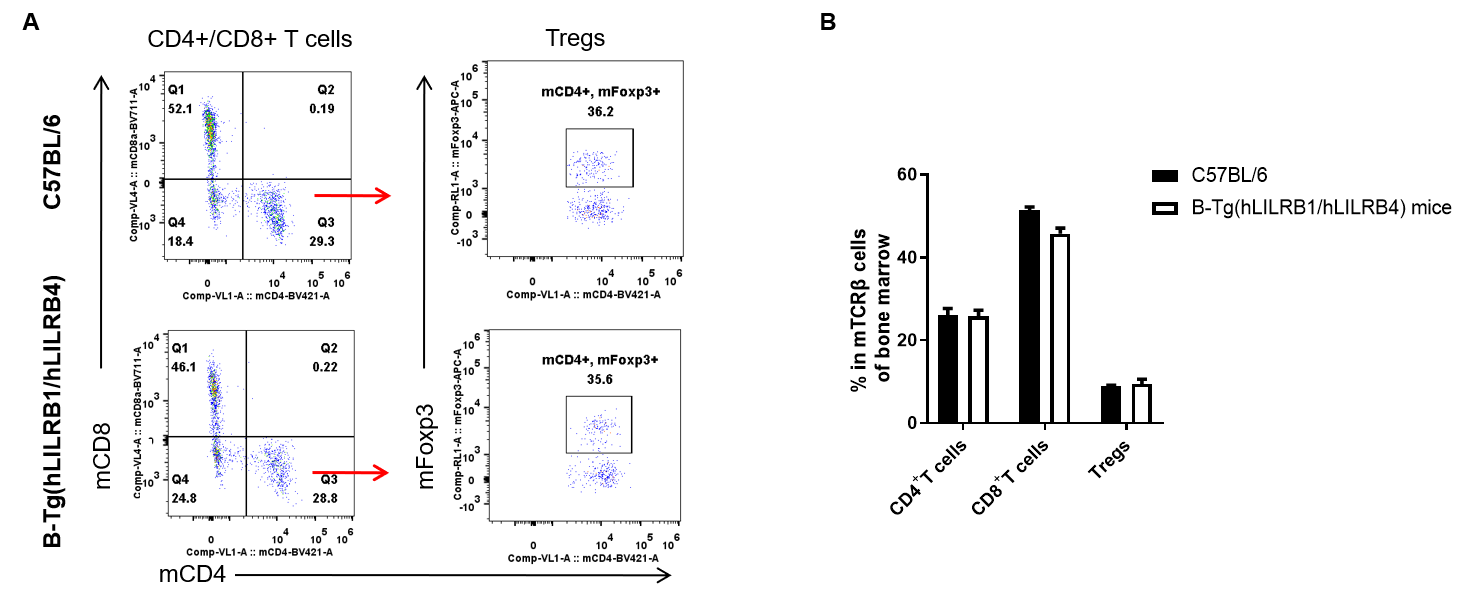
Analysis of bone marrow T cell subpopulations by FACS. Bone marrow leukocyte were isolated from female C57BL/6 and B-Tg(hLILRB1/hLILRB4) mice (n=3, 8-week-old). Flow cytometry analysis of the bone marrow leukocyte was performed to assess leukocyte subpopulations. A. Representative FACS plots. Single live CD45+ cells were gated for TCRβ+ T cell population and used for further analysis as indicated here. B. Results of FACS analysis. The percent of CD4+ T cells, CD8+ T cells and Tregs in B-Tg(hLILRB1/hLILRB4) mice were similar to those in the C57BL/6 mice, demonstrating that introduction of hLILRB1 and hLILRB4 does not change the overall development, differentiation or distribution of these T cell subtypes in bone marrow. Values are expressed as mean ± SEM.
Immune Cell Profiles in Blood

Analysis of blood leukocyte subpopulations by FACS. Blood leukocytes were isolated from female C57BL/6 and B-Tg(hLILRB1/hLILRB4) mice (n=3, 8-week-old). Flow cytometry analysis of the blood leukocytes were performed to assess leukocyte subpopulations. A. Representative FACS plots. Single live cells were gated for the CD45+ population and used for further analysis as indicated here. B. Results of FACS analysis. Percent of T cells, B cells, NK cells, dendritic cells, granulocytes, monocytes and macrophages in B-Tg(hLILRB1/hLILRB4) mice were similar to those in the C57BL/6 mice, demonstrating that LILRB1 and LILRB4 humanized does not change the overall development, differentiation or distribution of these cell types in blood. Values are expressed as mean ± SEM.
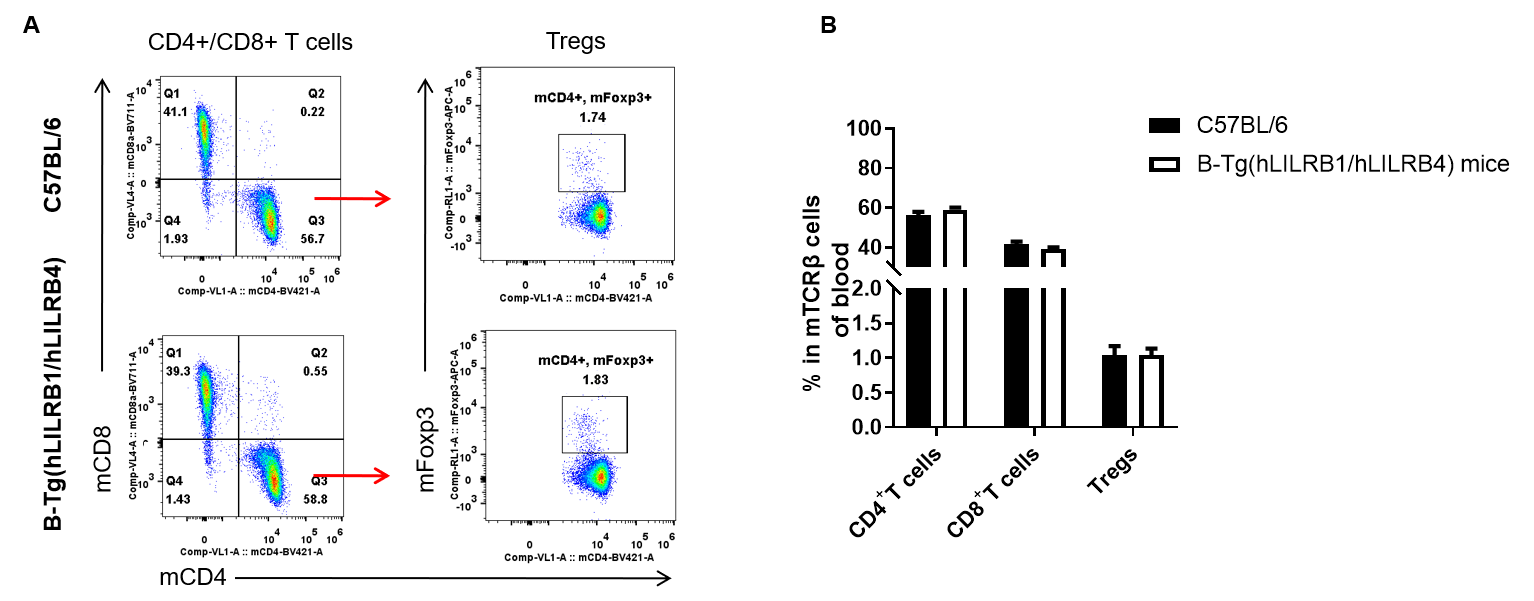
Analysis of blood T cell subpopulations by FACS. Blood leukocytes were isolated from female C57BL/6 and B-Tg(hLILRB1/hLILRB4) mice (n=3, 8-week-old). Flow cytometry analysis of the blood leukocytes were performed to assess leukocyte subpopulations. A. Representative FACS plots. Single live CD45+ cells were gated for TCRβ+ T cell population and used for further analysis as indicated here. B. Results of FACS analysis. The percent of CD4+ T cells, CD8+ T cells and Tregs in B-Tg(hLILRB1/hLILRB4) mice were similar to those in the C57BL/6 mice, demonstrating that introduction of hLILRB1 and hLILRB4 does not change the overall development, differentiation or distribution of these T cell subtypes in blood. Values are expressed as mean ± SEM.
-
Blood Chemistry Tests

-

Blood chemistry tests of B-Tg(hLILRB1/hLILRB4) mice. Serum from the C57BL/6 and B-Tg(hLILRB1/hLILRB4) mice (n=8, 9 week-old) was collected and analyzed for levels of indicators. The measurements of B-Tg(hLILRB1/hLILRB4) mice were similar to that in C57BL/6 mice, indicating that humanization does not change the health of related tissues, such as liver. Values are expressed as mean ± SEM.

Complete blood count (CBC). Blood from female C57BL/6 and B-Tg(hLILRB1/hLILRB4) mice (n=8, 9 week-old) was collected and analyzed for CBC. The measurements of B-Tg(hLILRB1/hLILRB4) mice were similar to that in C57BL/6 mice, indicating that humanization does not change blood cell composition and morphology. Values are expressed as mean ± SEM.
-
In vivo Efficacy of an Anti-Human LILRB4 Antibody

-
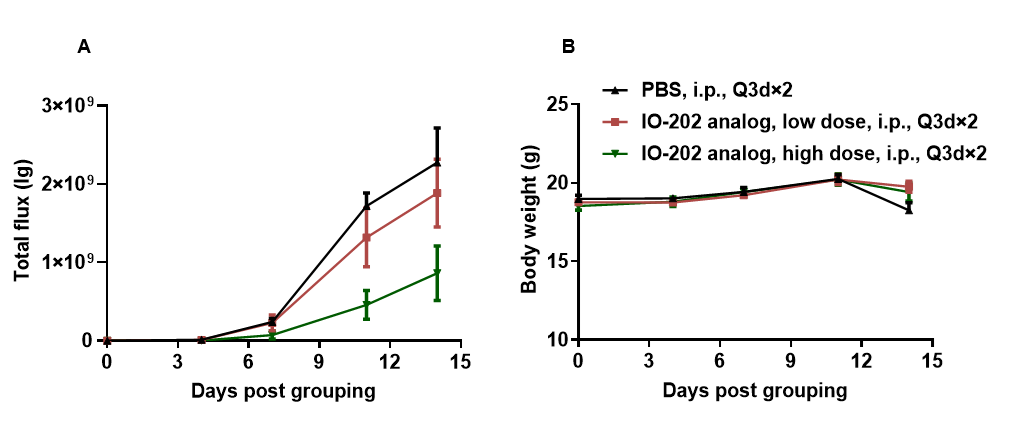
Antitumor activity of anti-human LILRB4 antibody in B-Tg(hLILRB1/hLILRB4) mice. (A) Anti-human LILRB4 antibody inhibited B-hLILRB4 luc EL4 lymphoma growth in B-Tg(hLILRB1/hLILRB4) mice. B-hLILRB4 luc EL4 cells (2×105) were injected by tail vein into B-Tg(hLILRB1/hLILRB4) mice (female, 6 week-old, n=6). Mice were grouped when total flux reached approximately 106 Ig, and treated with anti-hLILRB4 antibody in panel A. (B) Body weight changes during treatment. As shown in panel A, anti-hLILRB4 antibody IO-202(in house) was efficacious in controlling tumor growth in B-Tg(hLILRB1/hLILRB4) mice. Values are expressed as mean ± SEM.


